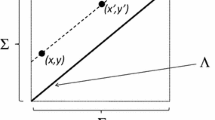Abstract
In many real-world gambles, a non-trivial amount of time passes before the uncertainty is resolved but after a choice is made. An individual may have a preference between gambles with identical probability distributions over final outcomes if they differ in the timing of resolution of uncertainty. In this domain, utility consists not only of the consumption of outcomes, but also the psychological utility induced by an unresolved gamble. We term this utility anxiety. Since a reflective decision maker may want to include anxiety explicitly in analysis of unresolved lotteries, a multiple-outcome model for evaluating lotteries with delayed resolution of uncertainty is developed. The result is a rank-dependent utility representation (e.g., Quiggin, 1982), in which period weighting functions are related iteratively. Substitution rules are proposed for evaluating compound temporal lotteries. The representation is appealing for a number of reasons. First, probability weights can be interpreted as the cognitive attention allocated to certain outcomes. Second, the model disaggregates strength of preference from temporal risk aversion and thus provides some insight into the old debate about the relationship between von Neumann–Morgenstern utility functions and strength of preference value functions.
Similar content being viewed by others
REFERENCES
Aczél, J. (1966), Lectures on Functional Equations and Their Applications, New York: Academic Press.
Aumann, R.J. (1962), Utility theory without the completeness axiom, Econometrica30: 445–462.
Bell, D.E. (1981), Components of risk aversion, in J.P. Brans (ed.), Operational Research’ 81, Amsterdam: North-Holland, pp. 371–378.
Bell, D.E. (1982), Regret in decision making under uncertainty, Operations Research30: 961–981.
Bell, D.E. (1985), Disappointment in decision making under uncertainty, Operations Research33: 1–27.
Bell, D.E. and Raiffa, H. (1988), Marginal value and intrinsic risk aversion, in D.E. Bell, H. Raiffa, and A. Tversky (eds.), Decision Making: Descriptive, Normative, and Prescriptive Interactions, Cambridge, UK: Cambridge University Press, pp. 384–397.
Bewley, T.F. (1986), Knightian decision theory: Part I, Cowles Foundation. Discussion Paper 807.
Camerer, C.F. and Ho, T.-H. (1994), Violations of the betweenness axiom and nonlinearity in probability, Journal of Risk and Uncertainty8: 167–196.
Cantor, S. (1991), A decision analytic approach to prenatal diagnosis, Ph.D. Dissertation. Decision Sciences, Harvard University, Cambridge.
Hong, C.-S., Karni, E. and Safra, Z. (1987), Risk aversion in the theory of expected utility with rank dependent probabilities, Journal of Economic Theory42: 370–381.
Dréze, J. and Modigliani, F. (1972), Consumption decisions under uncertainty, Journal of Economic Theory3: 308–355.
Dyer, J. and Sarin, R.K. (1982), Relative risk aversion, Management Science28: 875–886.
Ellsberg, D. (1954), Classical notions of measurable utility, Economic Journal64: 528–556.
Fishburn, P.C. (1970), Utility Theory for Decision Making,New York: JohnWiley.
Fishburn, P.C. (1991), Nontransitive preferences in decision theory, Journal of Risk and Uncertainty4: 113–134.
Kahneman, D. and Tversky, A. (1979), Prospect theory: an analysis of decision under risk, Econometrica47: 263–291.
Keeney, R.L. and Raiffa, H. (1976), Decisions with Multiple Objectives, New York: JohnWiley.
Keeney, R.L. and Winkler, R. (1985), Evaluating decision strategies for equity of public risks, Operations Research33, 955–970.
Koopmans, T.C. (1960), Stationary ordinal utility and impatience, Econometrica28: 287–309.
Kreps, D.M. (1988), Notes on the Theory of Choice, Boulder, CO: Westview Press.
Kreps, D.M. and Porteus, E.L. (1978), Temporal resolution of uncertainty and dynamic choice theory, Econometrica46: 185–200.
Loewenstein, G. (1987), Anticipation and the valuation of delayed consumption, Economic Journal97: 666–684.
Loomes, G. and Sugden, R. (1982), Regret theory: an alternative theory of rational choice under uncertainty, Economic Journal92: 805–824.
Loomes, G. and Sugden, R. (1986), Disappointment and dynamic consistency in choice under uncertainty, Review of Economic Studies53: 271–282.
Luce, R.D. and Raiffa, H. (1957), Games and Decisions, New York: John Wiley.
Machina, M.J. (1984), Temporal risk and nature of induced preferences, Journal of Economic Theory33: 199–231.
Machina, M.J. (1989), Dynamic consistency and non-expected utility models of choice under uncertainty, Journal of Economic Literature27: 1622–1668.
Markowitz, H. (1959), Portfolio Selection: Efficient Diversification of Investments, New Haven, CT: Yale University Press.
Marschak, J. (1950), Rational behavior, uncertain prospects, and measurable utility, Econometrica18: 111–141.
Miyamoto, J.M. and Wakker, P. (1996), Multiattribute utility theory without expected utility foundations, Operations Research44: 313–326.
Mossin, J. (1969), A note of uncertainty and preference in a temporal context, American Economic Review59: 172–174.
Pope, R. (1983), The pre-outcome period and the utility of gambling, in B.P.
Stigum and F. Wenstop (eds.), Foundations of Utility and Risk Theory with Applications, Dordrecht: Reidel, pp. 137–177.
Pratt J.W. (1964), Risk aversion in the small and in the large, Econometrica32: 122–136.
Prelec, D. (1990), A ‘pseudo-endowment’ effect, and its implication for some recent non-expected utility models, Journal of Risk and Uncertainty3: 247–259.
Prelec, D. (in press), The probability weighting function, Econometrica.
Quiggin, J. (1982), A theory of anticipated utility, Journal of Economic Behavior and Organization3: 323–343.
Raiffa, H. (1986), Back from prospect theory to utility theory, in M. Grauer, M. Thompson, and A. Wierzbicki (eds.), Plural Rationality and Interactive Decision Processes, Berlin: Springer-Verlag, pp. 100–113.
Röell, A. (1987), Risk aversion in Quiggin and Yaari's rank-ordermodel of choice under uncertainty, Economic Journal97, 143–159.
Sarin, R.K. (1982), Strength of preference and risky choice, Operations Research30: 982–995.
Segal, U. (1984), Nonlinear decision weights with the independence axiom, UCLA Working Paper No. 353.
Segal, U. (1987), Some remarks on Quiggin's anticipated utility, Journal of Economic Behavior and Organization8: 145–154.
Spence, M. and Zeckhauser, R. (1972), The effect of the timing of consumption decisions and the resolution of lotteries on the choice of lotteries, Econometrica40: 401–403.
Tversky, A. and Kahneman, D. (1991), Loss aversion in riskless choice: a reference-dependent model, Quarterly Journal of Economics106: 1039–1061.
Wakker, P.P. (1994), Separating marginal utility and probabilistic risk aversion, Theory and Decision36: 1–44.
Wu, G. (1996), Temporal risk and probability weights: rank-, sign-, and timing dependent utility, Harvard Business SchoolWorking Paper 92-093.
Wu, G. and Gonzalez, R. (1996), Curvature of the probability weighting function, Management Science, 42: 1676–1690.
Yaari, M.E. (1987), The dual theory of choice under risk, Econometrica55: 95–117.
Author information
Authors and Affiliations
Rights and permissions
About this article
Cite this article
Wu, G. Anxiety and Decision Making with Delayed Resolution of Uncertainty. Theory and Decision 46, 159–199 (1999). https://doi.org/10.1023/A:1004990410083
Issue Date:
DOI: https://doi.org/10.1023/A:1004990410083




